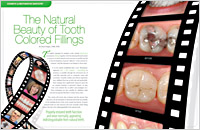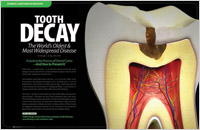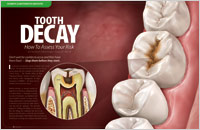 At Renew Dental Arts, we know that dental decay is one of the most common chronic diseases of our time. According to the CDC, tooth decay is 4 times more likely than asthma in those ages 14-17, and 9 out of 10 of us over the age of 20 having some form of tooth decay.
At Renew Dental Arts, we know that dental decay is one of the most common chronic diseases of our time. According to the CDC, tooth decay is 4 times more likely than asthma in those ages 14-17, and 9 out of 10 of us over the age of 20 having some form of tooth decay.
But that doesn't mean that there isn't hope! With nearly 15 years of experience, Dr. Miller has become an expert at removing dental decay and placing nearly invisible tooth colored fillings in it's place!
What is the Solea dental laser?
The Solea dental laser is a new, state of the art technology that allows Dr. Miller to remove dental caries (decayed tooth areas) without the need for anesthesia. Using CO2, the Solea laser is able to vaporize both hard and soft tissues in the mouth! While there will be some sensation and discomfort for the patient, it is not painful (as the drill would be), and hence no or little anesthesia is necessary! This allows the patient to sit back, relax, and enjoy having their dental care completed without stress.
Can the Solea laser be used for all fillings?
At this point we can't guarantee that we can use the Solea laser for each and everything filling. There are a variety of factors that could limit the ability to use the laser, such as if the areas of decay are in between teeth or if the decay extends past the enamel layer of the tooth.
Can the Solea laser be used for more than fillings?
Yes! The Solea laser can also be used for tongue and lip tie corrections, as well as various other soft tissue procedures such as crown lengthening or other cosmetic gum surgeries.
Types of Fillings
While there are multiple types of filling material available for use, at Renew Dental Arts we only use tooth colored material in our office. Why? Who wants a strange mix of metals in their mouth, just to save a few dollars? While they are strong, amalgam fillings will leave your tooth looking un-natural.

 Composite — A popular choice for those who don't want their fillings to show, composite is a mixture of plastic and glass, which actually bonds to the rest of the tooth. Composites are more expensive than amalgam fillings, and the newer materials can hold up almost as long. Less drilling of the tooth is necessary when placing composite as compared to amalgam. At Renew Dental Arts, we mainly offer tooth colored fillings, with 99% of our patients receiving a filling that matches their natural tooth color and shade.
Composite — A popular choice for those who don't want their fillings to show, composite is a mixture of plastic and glass, which actually bonds to the rest of the tooth. Composites are more expensive than amalgam fillings, and the newer materials can hold up almost as long. Less drilling of the tooth is necessary when placing composite as compared to amalgam. At Renew Dental Arts, we mainly offer tooth colored fillings, with 99% of our patients receiving a filling that matches their natural tooth color and shade.
Porcelain — These high-tech dental ceramics are strong, lifelike, and don't stain as composites can. They are sometimes more expensive than composites because they may require the use of a dental laboratory or specialized computer-generated technology. While considered the most aesthetic filling, they can also, because of their relatively high glass content, be brittle. We call these types of fillings inlays, onlays, or partial crowns.
Glass Ionomer — Made of acrylic and glass powders, these translucent fillings have the advantages of blending in pretty well with natural tooth color and releasing small amounts of fluoride to help prevent decay. They generally don't last as long as other restorative materials if placed on a biting or chewing surfaces of teeth. Dr. Miller recommends these types of fillings for children, as the fluoride will increase the strength of the tooth. Dr. Miller will also place these types of fillings on patients who have decay from drinking acidic drinks, as it will make these teeth more resistant to decay from these acidic drinks.
Watch Tooth-Colored Fillings Video
What to Expect After Getting a Filling
The numbness caused by your local anesthesia should wear off within a couple of hours. Until then, it's best to avoid drinking hot or cold liquids and eating on the side of your mouth with the new filling. Some sensitivity to hot and cold is normal in the first couple of weeks after getting a tooth filled. If it persists beyond that, or you have any actual pain when biting, it could signal that an adjustment to your filling needs to be made. Continue to brush and floss as normal every day, and visit the dental office at least twice per year for your regular checkups and cleanings. And remember, tooth decay is a very preventable disease; with good oral hygiene and professional care, you can make your most recent cavity your last!
Related Articles

The Natural Beauty of Tooth-Colored Fillings The public's demand for aesthetic tooth-colored (metal free) restorations (fillings) together with the dental profession's desire to preserve as much natural tooth structure as possible, has led to the development of special “adhesive” tooth-colored restorations... Read Article

Tooth Decay — A Preventable Disease Tooth decay is the number one reason children and adults lose teeth during their lifetime. Yet many people don't realize that it is a preventable infection. This article explores the causes of tooth decay, its prevention, and the relationship to bacteria, sugars, and acids... Read Article

Tooth Decay – How To Assess Your Risk Don't wait for cavities to occur and then have them fixed — stop them before they start. Modern dentistry is moving towards an approach to managing tooth decay that is evidence-based — on years of accumulated, systematic, and valid scientific research. This article discusses what you need to know to assess your risk and change the conditions that lead to decay... Read Article

